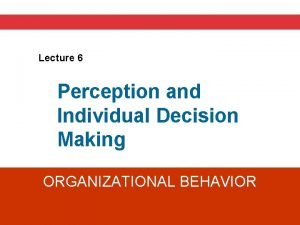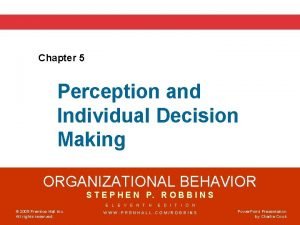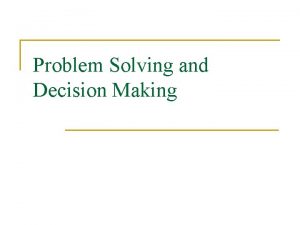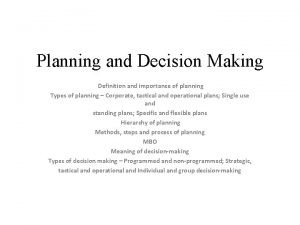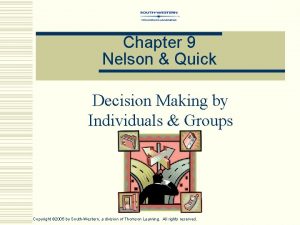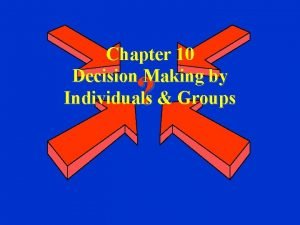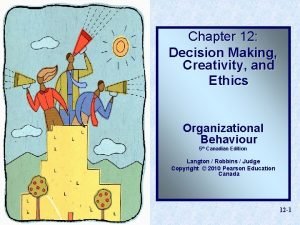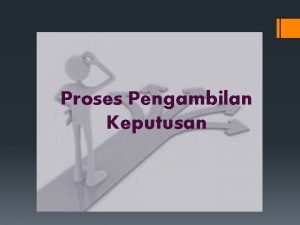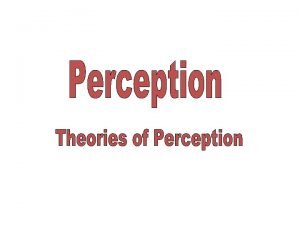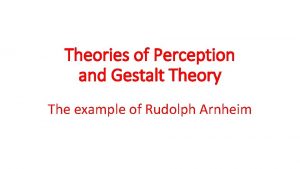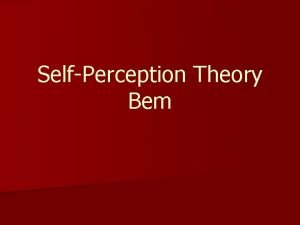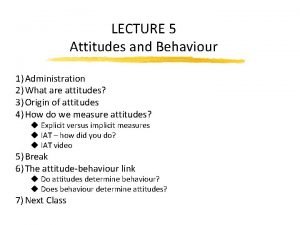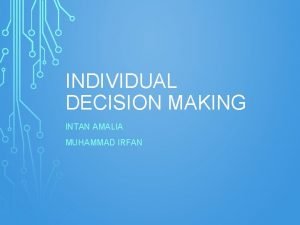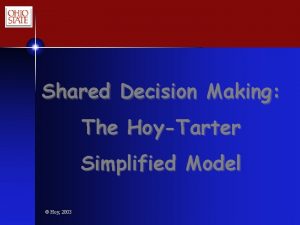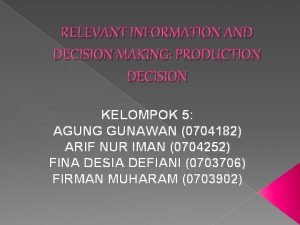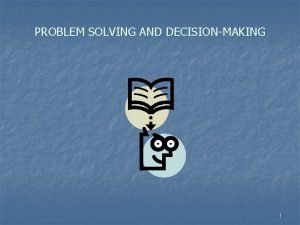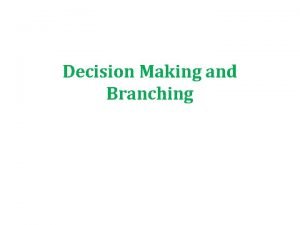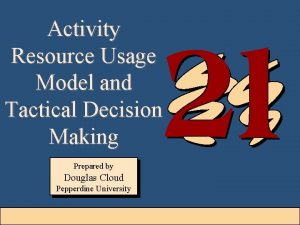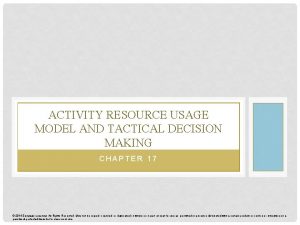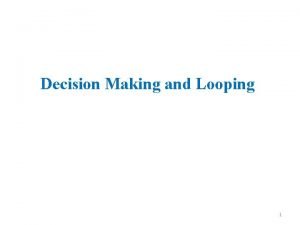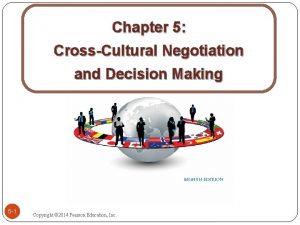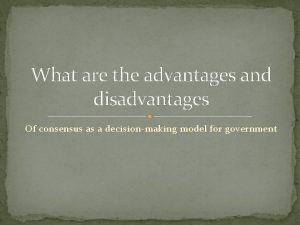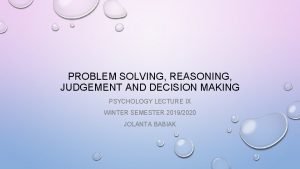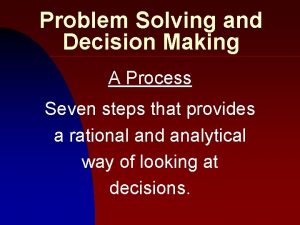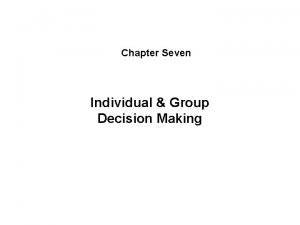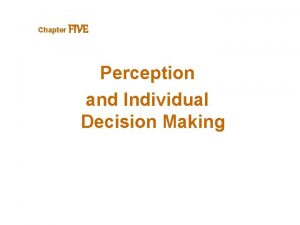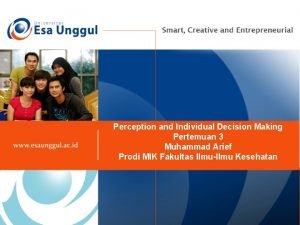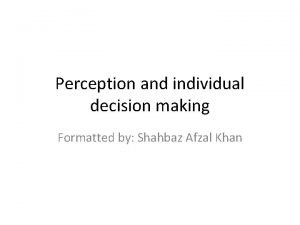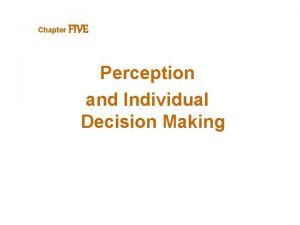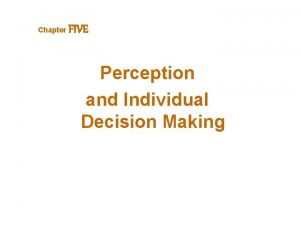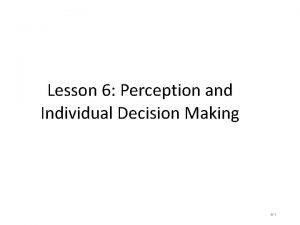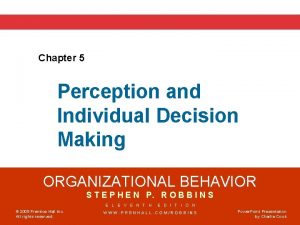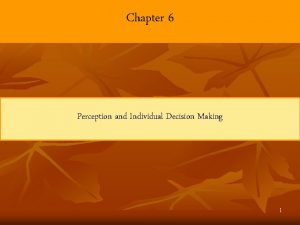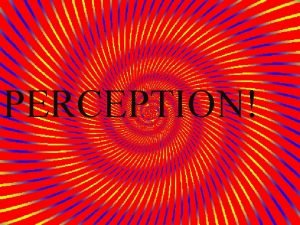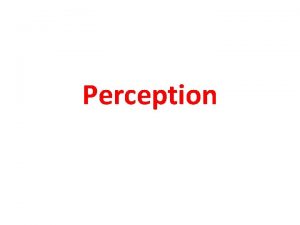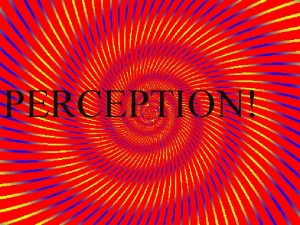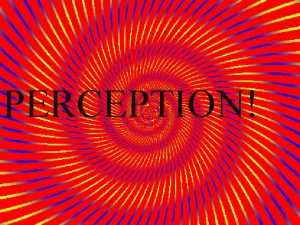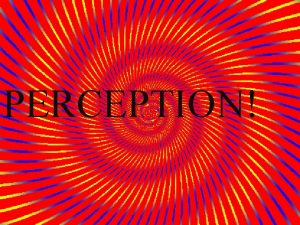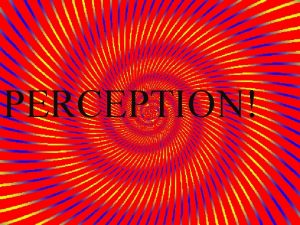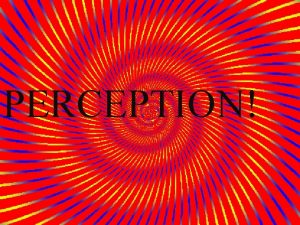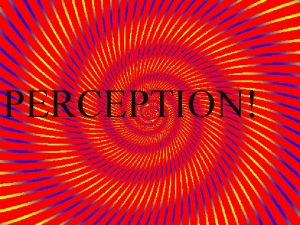Perception and Individual Decision Making Decision Making Theory











































- Slides: 43

Perception and Individual Decision Making (Decision Making Theory & Chapter 6 ) 學校組織行為專題研究 Organizational Behavior in school 報告人: 林純真 報告時間: 2011/12/07 6 -0





Decision Making Theory Ill-Structured Top Nonprogrammed Decisions Level Type 非程式化決策 Programmed Decisions 程式化決策 Well-Structured Lower 6 -5












Chapter 6 Learning Objectives Ø After studying this chapter, you should be able to: – Define perception and explain the factors that influence it. – Explain attribute theory and list the three determinants of attribution. – Identify the shortcuts individuals use in making judgments about others. – Explain the link between perception and decision making. – Apply the rational model of decision-making and contrast it with bounded rationality and intuition. – List and explain the common decision biases or errors. – Explain how individual differences and organizational constraints affect decision-making. – Contrast the three ethical decision criteria. – Define creativity and discuss the three-component model of creativity. 6 -17

What is Perception? and Why Is It Important? Ø Perception Ø A process by which individuals organize and interpret their sensory impressions in order to give meaning to their environment. ØPeople’s behavior is based on their perception of what reality is, not on reality itself. ØThe world as it is perceived is the world that is behaviorally important. 6 -18


Factors that Influence Perception See E X H I B I T 6 -1 6 -20

Attribution Theory: Judging Others (person perception ) Ø Our perception and judgment of others is significantly influenced by our assumptions of the other person’s internal state. – When individuals observe behavior, they attempt to determine whether it is internally or externally caused. • Internal causes are under that person’s control • External causes are not – person forced to act in that way 6 -21


Causation judged through Ø Distinctiveness Ø Shows different behaviors in different situations. 當事人的行為是否異常 Ø Consensus Ø Response is the same as others to same situation. 不同人遇到相同狀況均有相同反應 Ø Consistency Ø Responds in the same way over time. 當事人的表現越一致,易歸為內在歸因 6 -23

Elements of Attribution Theory See E X H I B I T 6 -24

Errors and Biases in Attributions Ø Fundamental Attribution Error(基本歸因誤差) – The tendency to underestimate the influence of external factors and overestimate the influence of internal factors when making judgments about the behavior of others – We blame people first, not the situation Ø Self-Serving Bias (自利性偏差) – The tendency for individuals to attribute their own successes to internal factors while putting the blame for failures on external factors – It is “our” success but “their” failure 6 -25


Another Shortcut: Stereotyping (刻板印象) Judging someone on the basis of one’s perception of the group to which that person belongs – a prevalent and often useful, if not always accurate, generalization Ø先認定別人是屬於某種團體,據此判斷他的行為 ØProfiling – A form of stereotyping in which members of a group are singled out for intense scrutiny based on a single, often racial, trait. 會因對某團體的偏見,而做出不正確的知覺判斷 6 -27

Specific Shortcut Applications in Organizations Ø Employment Interview – Perceptual biases of raters affect the accuracy of interviewers’ judgments of applicants – Formed in a single glance – 1/10 of a second! Ø Performance Expectations – Self-fulfilling prophecy (Pygmalion effect-預言效果): The lower or higher performance of employees reflects preconceived leader expectations about employee capabilities Ø Performance Evaluations – Appraisals are often the subjective (judgmental) perceptions of appraisers of another employee’s job performance – Critical impact on employees 6 -28

Perceptions and Individual Decision Making Ø Problem – A perceived discrepancy between the current state of affairs and a desired state Ø Decisions – Choices made from among alternatives developed from data Ø Perception Linkage: – All elements of problem identification and the decision making process are influenced by perception. • Problems must be recognized • Data must be selected and evaluated 6 -29

Decision-Making Models in Organizations Ø Rational Decision-Making – The “perfect world” model: assumes complete information, all options known, and maximum payoff. – Six step decision-making process Ø Bounded Reality – The “real world” model: seeks satisfactory and sufficient solutions from limited data and alternatives Ø Intuition – A non-conscious process created from distilled experience that results in quick decisions • Relies on holistic associations • Affectively charged – engaging the emotions See E X H I B I T 5 -3 6 -30

Common Biases and Errors in Decision-Making Ø Overconfidence Bias(過度自信的偏誤) – Believing too much in our own ability to make good decisions – especially when outside of own expertise Ø Anchoring Bias(定錨偏誤) – Using early, first received information as the basis for making subsequent judgments Ø Confirmation Bias(確定偏誤) – Selecting and using only facts that support our decision Ø Availability Bias (可利用性偏誤) – Emphasizing information that is most readily at hand • Recent • Vivid 6 -31

More Common Decision-Making Errors Ø Escalation of Commitment(信守以往)往 – Increasing commitment to a decision in spite of evidence that it is wrong – especially if responsible for the decision! Ø Randomness Error (隨機偏誤) – Creating meaning out of random events - superstitions Ø Winner’s Curse – Highest bidder pays too much due to value overestimation – Likelihood increases with the number of people in auction Ø Hindsight Bias(後見之明的偏誤) – After an outcome is already known, believing it could have been accurately predicted beforehand 6 -32

Individual Differences in Decision-Making Ø Personality – Conscientiousness may effect escalation of commitment • Achievement-strivers are likely to increase commitment • Dutiful people are less like to have this bias – Self-Esteem • High self-esteem people are susceptible to self-serving bias Ø Gender • Women analyze decisions more than men – rumination(反芻) • Women are twice as likely to develop depression • Differences develop early 6 -33

Organizational Constraints Ø Performance Evaluation – Managerial evaluation criteria influence actions Ø Reward Systems – Managers will make the decision with the greatest personal payoff for them Ø Formal Regulations – Limit the alternative choices of decision makers Ø System-imposed Time Constraints – Restrict ability to gather or evaluate information Ø Historical Precedents – Past decisions influence current decisions 6 -34

Ethics in Decision Making Ø Ethical Decision Criteria – Utilitarianism(功利觀點) • Decisions made based solely on the outcome • Seeking the greatest good for the greatest number • Dominant method for businesspeople – Rights(權益觀點) • Decisions consistent with fundamental liberties and privileges • Respecting and protecting basic rights of individuals such as whistleblowers – Justice(正義觀點) • Imposing and enforcing rules fairly and impartially • Equitable distribution of benefits and costs 6 -35

Ethical Decision-Making Criteria Assessed Ø Utilitarianism – Pro: Promotes efficiency and productivity – Con: Can ignore individual rights, especially minorities Ø Rights – Pro: Protects individuals from harm; preserves rights – Con: Creates an overly legalistic work environment Ø Justice – Pro: Protects the interests of weaker members – Con: Encourages a sense of entitlement 6 -36

Improving Creativity in Decision Making Ø Creativity – The ability to produce novel and useful ideas Ø Who has the greatest creative potential? – Those who score high in Openness to Experience – People who are intelligent, independent, self-confident, risktaking, have an internal locus-of-control, tolerant of ambiguity, low need for structure, and who persevere in the face of frustration 6 -37

The Three Component Model of Creativity Proposition that individual creativity results from a mixture of three components – Expertise is the foundation – Creative-Thinking Skills are the personality characteristics associated with creativity – Intrinsic Task Motivation is the desire to do the job because of its characteristics Intrinsic Task Motivation Expertise Creative. Thinking Skills See E X H I B I T 6 -4 6 -38

Global Implications Ø Attributions – There are cultural differences in the ways people attribute cause to observed behavior Ø Decision-Making – No research on the topic: assumption of “no difference” – Based on our awareness of cultural differences in traits that affect decision making, this assumption is suspect Ø Ethics – No global ethical standards exist – Asian countries tend not to see ethical issues in “black and white” but as shades of gray – Global companies need global standards for managers 6 -39

Summary and Managerial Implications Ø Perception: – People act based on how they view their world – What exists is not as important as what is believed – Managers must also manage perception Ø Individual Decision Making – Most use bounded rationality: they satisfice – Combine traditional methods with intuition and creativity for better decisions • Analyze the situation and adjust to culture and organizational reward criteria • Be aware of, and minimize, biases 6 -40

Ways to Improve Decision Making l Analyze the situation and adjust your decision making style to fit the situation. l Be aware of biases and try to limit their impact. l Combine rational analysis with intuition to increase decision-making effectiveness. l Don’t assume that your specific decision style is appropriate to every situation. l Enhance personal creativity by looking for novel solutions or seeing problems in new ways, and using analogies. 6 -41

Thanks for your attention!! 6 -42
 Perception and individual decision making
Perception and individual decision making Perception and individual decision making
Perception and individual decision making Individual and group decision making
Individual and group decision making Importance of decision making
Importance of decision making Individual and group decision making
Individual and group decision making Horizontal solutions group synergy
Horizontal solutions group synergy Individual and group decision making
Individual and group decision making Individual decision making in organizational behaviour
Individual decision making in organizational behaviour No decision snap decision responsible decision
No decision snap decision responsible decision Financial decision
Financial decision Model proses pembuatan keputusan menurut herbert a. simon
Model proses pembuatan keputusan menurut herbert a. simon Gregorys constructivist theory
Gregorys constructivist theory Film als kunst
Film als kunst Overjustification effect
Overjustification effect Gestalt approach
Gestalt approach Risk perception theory
Risk perception theory Self perception theory
Self perception theory Individual decision
Individual decision Decision tree and decision table examples
Decision tree and decision table examples Using recursion in models and decision making
Using recursion in models and decision making Using recursion in models and decision making sheet 3
Using recursion in models and decision making sheet 3 Chapter 6 prices and decision making assessment answers
Chapter 6 prices and decision making assessment answers Hoy-tarter model of shared decision making
Hoy-tarter model of shared decision making Decision making and relevant information
Decision making and relevant information Best books on problem solving and decision making
Best books on problem solving and decision making Five step decision making process
Five step decision making process Chapter 2 economic systems and decision making answer key
Chapter 2 economic systems and decision making answer key Decision making and branching in c
Decision making and branching in c What are the basic elements of planning
What are the basic elements of planning Management chapter 5 planning and decision making
Management chapter 5 planning and decision making Decision making goal setting
Decision making goal setting Chapter 2 economic systems and decision making
Chapter 2 economic systems and decision making Activity resource usage model and tactical decision making
Activity resource usage model and tactical decision making Activity resource usage model and tactical decision making
Activity resource usage model and tactical decision making Decision making and time management
Decision making and time management Sentinel controlled loop flowchart
Sentinel controlled loop flowchart Cross cultural negotiation and decision making
Cross cultural negotiation and decision making Decision making and relevant information
Decision making and relevant information What are some of the prominent advantages of consensus
What are some of the prominent advantages of consensus Reasoning judgement decision making relaxing
Reasoning judgement decision making relaxing 7 steps of problem solving and decision making
7 steps of problem solving and decision making Chapter 2 economic systems and decision making
Chapter 2 economic systems and decision making Characteristics of decision making
Characteristics of decision making Sports and entertainment marketing performance indicators
Sports and entertainment marketing performance indicators
